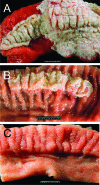How to become a top model: impact of animal experimentation on human Salmonella disease research
- PMID: 21343352
- PMCID: PMC3088149
- DOI: 10.1128/IAI.01369-10
How to become a top model: impact of animal experimentation on human Salmonella disease research
Abstract
Salmonella serotypes are a major cause of human morbidity and mortality worldwide. Over the past decades, a series of animal models have been developed to advance vaccine development, provide insights into immunity to infection, and study the pathogenesis of human Salmonella disease. The successive introduction of new animal models, each suited to interrogate previously neglected aspects of Salmonella disease, has ushered in important conceptual advances that continue to have a strong and sustained influence on the ideas driving research on Salmonella serotypes. This article reviews important milestones in the use of animal models to study human Salmonella disease and identify research needs to guide future work.
Figures






References
-
- Arthur G., et al. 2001. Trends in bloodstream infections among human immunodeficiency virus-infected adults admitted to a hospital in Nairobi, Kenya, during the last decade. Clin. Infect. Dis. 33:248–256 - PubMed
-
- Berkley J. A., et al. 2005. Bacteremia among children admitted to a rural hospital in Kenya. N. Engl. J. Med. 352:39–47 - PubMed
Publication types
MeSH terms
Grants and funding
LinkOut - more resources
Full Text Sources
Other Literature Sources
Miscellaneous

